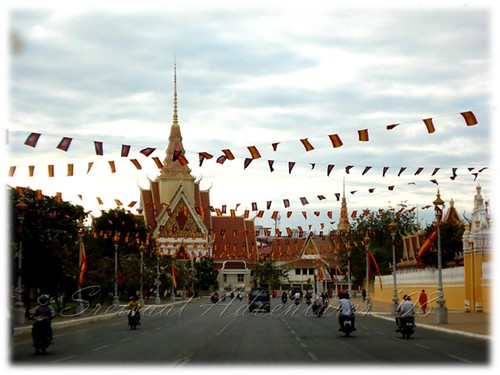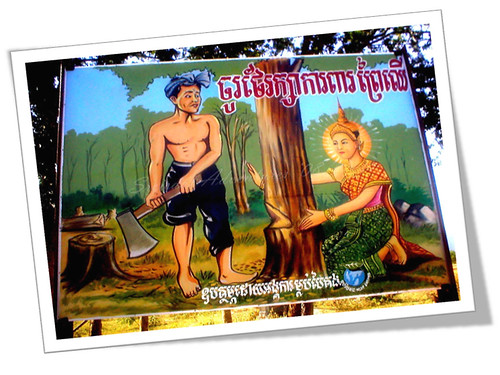>Wordless Wednesday #30 – Viva, Espana! Cheyor, Kampuchea!
>
The Queen of Spain visits the Royal Kingdom of Cambodia.
Check out other Wordless Wednesday photos here.
Read More>Photo Hunt # 15: Wooden
>
Hi guys. I am finally back again, and this time I am posting my entry for this week’s Photo Hunt. This week’s theme is “wooden”. It reminds me of the song “Wooden Heart” by the Bizarre Love Triangle in the 90s, if I am not mistaken.
But I digress now. Here is my take for this week’s theme:
The wooden cells of Tuol Sleng Prison:
Tuol Sleng Genocide Museum used to be a high school in the 70s but was transformed into the infamous prison and interrogation center called the Security Prison 21, or S-21, during the Khmer Rouge regime in Cambodia. Classrooms were divided and made into crude prison cells (see above photo). Survivors of S-21 describe the horrors that they and countless others had suffered while in prison. Today, these wooden cells still bear signs of cruelty and torture; it stand as witness to the many atrocities committed by the Khmer Rouge. In my 8 years here in Cambodia, I have visited it twice, and that’s because my friends were here and I had to take them around. Visiting Tuol Sleng is not for the faint-hearted. Those who were brave enough to visit left with a heavy heart.
Read More>Wordless Wednesday #29: Buddhism and Forestry
Check out other Wordless Wednesday photos.
n.b.: Please excuse me, I know it is supposed to be wordless but I couldn’t help but explain the link between Buddhism, Cambodia’s religion, and the forests.
A lot of things has been said about the forests of Cambodia and one thing is for sure – the forests are rapidly disappearing with the country’s opening to a market-oriented economy. Here’s a section of what I wrote years ago:
Forest cover has decreased from over 70% in 1970 to around 35% today (depending on which source you are using), and many globally important mammals such as kouprey, tigers, and elephants are on the path to extinction. The forests, upon which local people depended for firewood, medicines, building materials, and religious or spiritual value, have been ruthlessly destroyed by logging companies.
Given the traditional prestige of Buddhist monks among the population and the natural ecological orientation of Buddhism as a belief system and way of life, monks are a prime target group for environmental education and awareness (EE) programs in Cambodia. They are capable of playing an important social role in guiding local populations in understanding, protecting, and improving the environment and in exerting moral pressure on those abusing the environment to change their behavior. A complementary relationship exists between pagodas (the wats and the watarams – the temples and their compounds) and their villages, instructing and providing guidance for the local populations on ethical and practical aspects of environmental protection, management, and enhancement.
To read more, you can find the whole post about my work with the Cambodian Buddhist monks here.
Read MoreCheck out other Wordless Wednesday photos.
n.b.: Please excuse me, I know it is supposed to be wordless but I couldn’t help but explain the link between Buddhism, Cambodia’s religion, and the forests.
A lot of things has been said about the forests of Cambodia and one thing is for sure – the forests are rapidly disappearing with the country’s opening to a market-oriented economy. Here’s a section of what I wrote years ago:
Forest cover has decreased from over 70% in 1970 to around 35% today (depending on which source you are using), and many globally important mammals such as kouprey, tigers, and elephants are on the path to extinction. The forests, upon which local people depended for firewood, medicines, building materials, and religious or spiritual value, have been ruthlessly destroyed by logging companies.
Given the traditional prestige of Buddhist monks among the population and the natural ecological orientation of Buddhism as a belief system and way of life, monks are a prime target group for environmental education and awareness (EE) programs in Cambodia. They are capable of playing an important social role in guiding local populations in understanding, protecting, and improving the environment and in exerting moral pressure on those abusing the environment to change their behavior. A complementary relationship exists between pagodas (the wats and the watarams – the temples and their compounds) and their villages, instructing and providing guidance for the local populations on ethical and practical aspects of environmental protection, management, and enhancement.
To read more, you can find the whole post about my work with the Cambodian Buddhist monks here.
Read More>Wordless Wednesday #29: Buddhism and Forestry
Check out other Wordless Wednesday photos.
n.b.: Please excuse me, I know it is supposed to be wordless but I couldn’t help but explain the link between Buddhism, Cambodia’s religion, and the forests.
A lot of things has been said about the forests of Cambodia and one thing is for sure – the forests are rapidly disappearing with the country’s opening to a market-oriented economy. Here’s a section of what I wrote years ago:
Forest cover has decreased from over 70% in 1970 to around 35% today (depending on which source you are using), and many globally important mammals such as kouprey, tigers, and elephants are on the path to extinction. The forests, upon which local people depended for firewood, medicines, building materials, and religious or spiritual value, have been ruthlessly destroyed by logging companies.
Given the traditional prestige of Buddhist monks among the population and the natural ecological orientation of Buddhism as a belief system and way of life, monks are a prime target group for environmental education and awareness (EE) programs in Cambodia. They are capable of playing an important social role in guiding local populations in understanding, protecting, and improving the environment and in exerting moral pressure on those abusing the environment to change their behavior. A complementary relationship exists between pagodas (the wats and the watarams – the temples and their compounds) and their villages, instructing and providing guidance for the local populations on ethical and practical aspects of environmental protection, management, and enhancement.
To read more, you can find the whole post about my work with the Cambodian Buddhist monks here.
Read More









Follow Us!